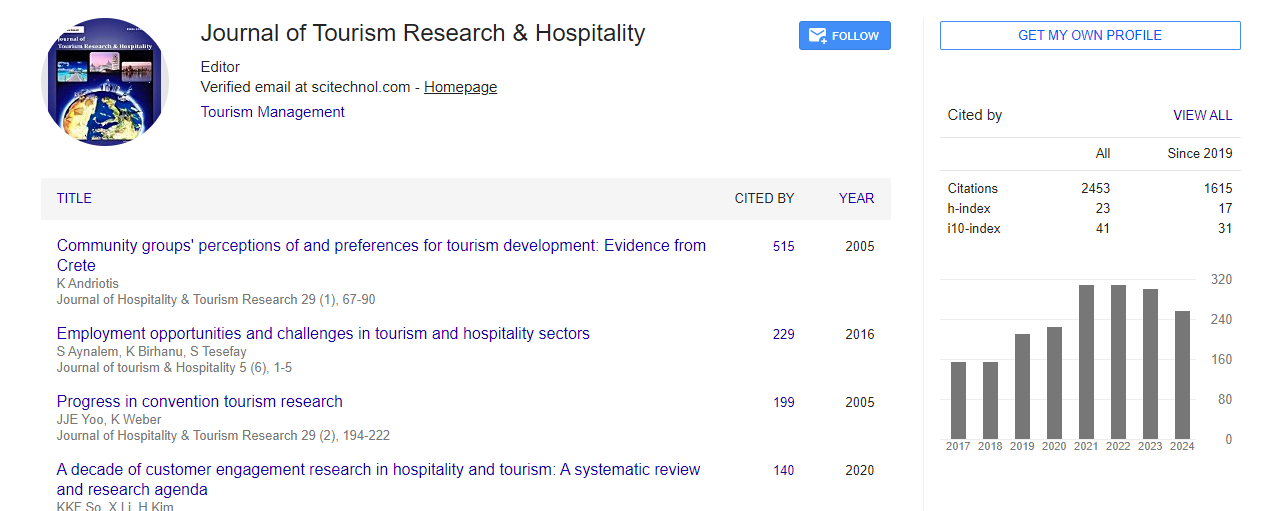Commentary, J Tourism Res Hospitality Vol: 12 Issue: 4
Exploring the Strategies in Tourism Marketing and their Applications
Klen Jose*
1Department of Tourism, Griffith University, Brisbane, Australia
*Corresponding Author: Klen Jose,
Department of Tourism, Griffith University,
Brisbane, Australia
E-mail: klen_jose@22gu.au
Received date: 24 July, 2023, Manuscript No. JTRH-23-114400;
Editor assigned date: 27 July, 2023, PreQC No. JTRH-23-114400 (PQ);
Reviewed date: 10 August, 2023, QC No. JTRH-23-114400;
Revised date: 17 August, 2023, Manuscript No. JTRH-23-114400 (R);
Published date: 24 August, 2023, DOI: 10.4172/2324-9110.10001044
Citation: Jose K (2023) Exploring the Strategies in Tourism Marketing and their Applications . J Tourism Res Hospitality 12:4.
Description
Tourism marketing plays a pivotal role in shaping the experiences of travelers and driving economic growth for destinations. It's a dynamic field that continuously evolves to meet the changing demands and preferences of modern travelers. Tourism marketing has undergone a significant transformation in recent years, largely due to advancements in technology and changing consumer behavior. Travellers now have access to vast amounts of information at their fingertips, which has altered the way they plan and book trips. As a result, tourism marketers must adapt to remain relevant and effective.
Strategies in tourism marketing
Digital platforms are the cornerstone of modern tourism marketing. This strategy includes using websites, social media, Search Engine Optimization (SEO), and online advertising to reach a global audience. Effective digital marketing requires a user-friendly website, an engaging social media presence, and well-executed online campaigns. Sharing valuable and relevant content is a powerful way to engage with potential travellers. Content can include blog posts, videos, info graphics, and more. By providing useful information and narrative, destinations can develop a strong connection with their target audience.
Tailoring marketing messages and offers to individual preferences is becoming increasingly important. Data analytics and customer profiling can help tourism marketer’s gives personalized experiences that resonate with travellers, making them more likely to choose a particular destination or service. Collaborating with influencers and travel bloggers can expand a destination's reach and credibility. Authentic recommendations from trusted figures in the travel industry can greatly influence travellers’ decisions.
As awareness of environmental and social issues grows, sustainable tourism has gained prominence. Tourism marketers can promote ecofriendly accommodations, responsible travel practices, and conservation efforts as part of their marketing strategies. In times of crisis, effective communication is essential. Tourism marketers should have a crisis management plan in place to address unforeseen events, such ass natura l disasters or health emergencies, to minimize negative impacts on th e destination's reputation.
With the rise of smartphones, mobile optimization is essential. Websites and booking systems should be mobile-friendly, and mobile apps can enhance the visitor experience by providing real-time information and navigation assistance. Tourism marketers can collaborate with online booking platforms to ensure that their accommodations, tours and activities are easily accessible to travellers. These platforms often have wide-reaching audiences and powerful search functionalities.
Active social media presence allows destinations to engage with travelers directly. Posting captivating visuals, running contests, and responding to user-generated content can foster a sense of community and excitement around the destination. Email campaigns remain a valuable tool in tourism marketing. They can be used to send personalized offers, travel tips, and updates to subscribers, keeping them engaged and informed. Tourism marketers can employ data analysis tools to gain insights into traveller behavior. Understanding what motivates travellers and how they interact with marketing materials can inform future strategies.
Collaborating with other stakeholders in the tourism industry, such as airlines, hotels, and local businesses, can amplify marketing efforts. Joint marketing campaigns and cross-promotions can benefit all parties involved. Technologies like Virtual Reality (VR) and Augmented Reality (AR) provide innovative ways to promote places. Potential tourists can be captivated and given an idea of the sights waiting for them through immersive narrative, interactive encounters, and virtual tours.
Conclusion
Tourism marketing is a multifaceted field that demands adaptability and innovation. By embracing digital strategies, personalization, sustainable practices, and collaboration, tourism marketers can successfully attract travellers and develop memorable experiences. In an era where travellers seek authenticity and convenience, mastering these strategies is essential for the success of any destination or tourism-related business. As the industry continues to evolve, staying ahead of the curve will be the key to achieving lasting success in tourism marketing.
 Spanish
Spanish  Chinese
Chinese  Russian
Russian  German
German  French
French  Japanese
Japanese  Portuguese
Portuguese  Hindi
Hindi 

